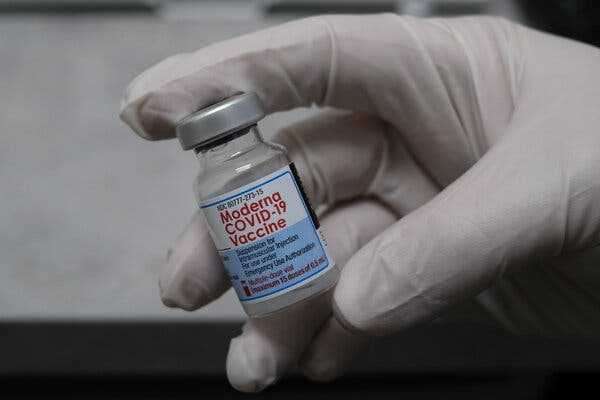The panel’s recommendation is a key step toward authorizing the vaccine for those children, but it is not the final say.
-
Send any friend a story
As a subscriber, you have “>10 gift articles to give each month. Anyone can read what you share.
Give this article
- Read in app
This article is part of our Daily Covid Briefing

A vial of the Moderna coronavirus vaccine at Altru Chemists pharmacy in Brooklyn last year.
An independent panel of experts advising the Food and Drug Administration is scheduled to vote on Tuesday on whether to recommend to the agency that Moderna’s coronavirus vaccine be authorized for children and adolescents ages 6 to 17.
The panel’s recommendation is a key step toward authorizing the vaccine for those children, but it is not the final say. The F.D.A., the Centers for Disease Control and Prevention and state health departments all still have roles to play in deciding whether to add the Moderna vaccine as an authorized option for that age group, which can already receive the Pfizer-BioNTech vaccine.
There are also applications from those two manufacturers pending for vaccines in younger children, who are not yet eligible for either one. They are being considered separately; the advisory panel is scheduled to make recommendations on them on Wednesday.
Here are the next steps for the Moderna application for children and adolescents 6 to 17.
The F.D.A.
-
As the agency within the Department of Health and Human Services that supervises medications and related matters, the F.D.A. will consider the advisory panel’s recommendation. The agency usually follows the advisory panel’s advice, but it is free to make changes or reject the recommendation outright.
-
Once the F.D.A. completes its review, it issues a determination.
The C.D.C.
-
If the F.D.A. authorizes the vaccine for children and adolescents, another advisory panel, this one set up by the C.D.C., will review that decision and vote on whether to recommend the vaccine’s use for that age group.
-
Once the panel has weighed in, the director of the C.D.C., Dr. Rochelle P. Walensky, issues the agency’s guidance to medical providers on whether and when to use the Moderna vaccine in children and adolescents.
-
Like the F.D.A., the C.D.C. usually follows the nonbinding recommendations of its advisory panel. But there have been exceptions: Last September, after the C.D.C. panel rejected the F.D.A.’s recommendation that frontline workers be included among those eligible for a Pfizer-BioNTech booster, Dr. Walensky overrode the C.D.C.’s advisers and sided with the F.D.A.
State agencies and providers
The C.D.C.’s guidance is deeply influential for state health departments, doctors, pharmacies, health care institutions and the public. States generally follow the guidance, but can set their own rules.
The timeline
Once the F.D.A.’s expert panel issues its recommendation, the process can move quickly. When the Pfizer-BioNTech vaccine was considered last year for use in adolescents 12 to 15, the F.D.A. authorized it on May 10, the C.D.C. panel weighed in two days later, and Dr. Walensky issued guidance swiftly after that. By May 13, shots were being administered to teenagers across the country.
Source: nytimes.com



